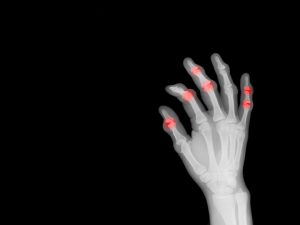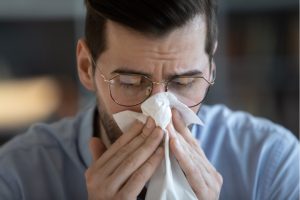In winter, we know we have caught a seasonal illness because of the symptoms: fever, cough, sneezing, inflammation, runny nose… We blame the virus for our discomfort. And although none of these would happen without the infection, in reality the whole situation that annoys us so much is not the direct action of the virus, but the manifestation of our body’s fight against it; it’s not the illness, but the defence. Without these weapons to fight the invader, we would probably be worse off, and we might not even be aware of the infection until it was too late. Here we look at how these strategies of the body against illness help us to get better.
Inflammation
Inflammation is the body’s basic response to infection, the mobilisation of its defences. In the face of infection or other aggression, cells of the immune system gather at the site of the attack. Inflammation is considered to be part of the innate or non-specific response, launching pathogen-devouring cells such as macrophages and neutrophils, but the release of hundreds of mediator molecules (cytokines) and the dilation of blood vessels also attract the cells responsible for the acquired or specific response, the B (antibody-producing) and T (system regulating and killing infected cells) lymphocytes.

The five typical signs of inflammation are heat, pain, swelling, redness and loss of tissue function. Heat is not just the product of increased blood flow due to dilated vessels: a rise of 1-2°C is due to the activity of the immune cells themselves, which is related to the action of fever, as we shall see. But inflammation is a double-edged sword: if chronic, it can cause disease, including cancer and perhaps neurodegenerative diseases such as Alzheimer’s.
Fever
Fever is the main symptom of any winter infection. The boundary of 37°C, the normal physiological temperature, often makes the difference for many people between going about their daily lives or staying at home and convalescing. Fever is debilitating, can be dangerous and takes an extra metabolic toll on the body, requiring 12.5% more energy for each degree increase. And yet it is generally accepted that fever helps to fight infection, although it is less obvious how it does so.
Fever is a rise in the body’s thermostat—located in the hypothalamus of the brain—unlike hyperthermia or heat stroke, where the body’s temperature rises but the thermostat doesn’t move; with fever, the standard temperature rises to make it easier to fight infection. This explains why we feel cold and shiver, because the new baseline temperature is higher and you feel comparatively colder.

A few degrees higher is thought to make it harder for viruses and bacteria to replicate, as well as lubricating the immune machinery and allowing the release of infection-fighting heat stress molecules. But some scientists suggest there is more to the story: fever adds degrees to the local heat of inflammation generated by immune cells, boosting the production of oxidative molecules. The result is a hot, acidic, low-oxygen environment that weakens the attacker, but is optimal for defence. This is why experts recommend: “let fever do its job”; “blocking fever can be harmful because fever, along with other sickness symptoms, evolved as a defence against infection.”
Runny nose
Our airways are lined with cells that produce mucus, a sticky substance that acts as a first line of defence to trap foreign elements, including viruses and bacteria. These cells have tiny hairs called cilia that beat rhythmically to move the particles trapped in the mucus from the bottom of the trachea to the upper airways, where we can swallow them or cough them out. Infection increases the production of mucus; the advice to drink plenty of fluids during these illnesses is intended to maintain this mechanism that helps us fight off the invader.

Coughing and sneezing
Coughing and sneezing are among the most annoying symptoms of respiratory disease, especially when they become persistent and uncontrollable. But they are important defensive reflex mechanisms that keep our airways clear of dust, food particles and other irritants. In the nasal mucosa, irritants cause the release of histamines, which trigger nasal congestion and sneezing.
Coughing protects our respiratory system. When the epithelium of the trachea, larynx and other regions receives a mechanical or chemical stimulus—including acid, heat or spiciness—it sends a signal via the vagus nerve to the medulla in the brain, which responds with commands to various organs and tissues: the diaphragm, intercostal and abdominal muscles, glottis, vocal cords and trachea. As a result, we expel air from the bronchi at high speed.

However, coughing is also a double-edged sword: infections of the respiratory tract cause the secretion of inflammatory molecules that lead to coughing. And in this case, coughing does us no good. Instead, it is the virus that takes advantage of it, hacking our natural defence mechanism to spread through the air and reach new hosts. In these cases, coughing is actually harmful: the excess mucus irritates the throat and makes us cough, but coughing irritates the throat even more and fatigues the cilia responsible for expelling the mucus.
Comments on this publication